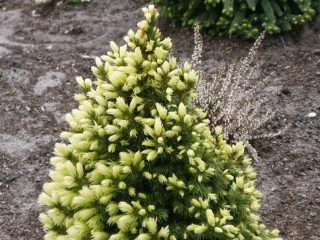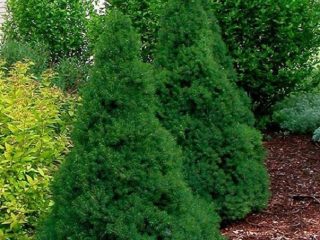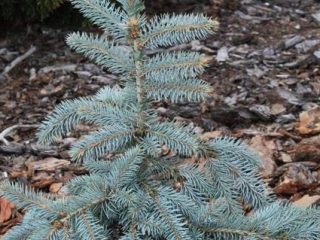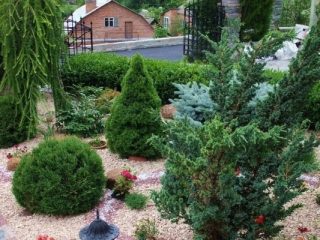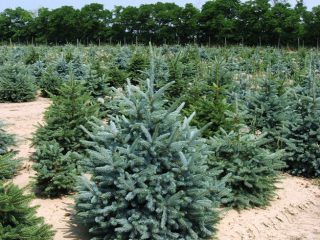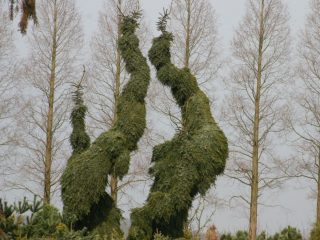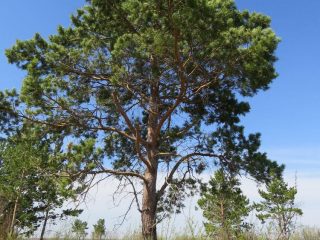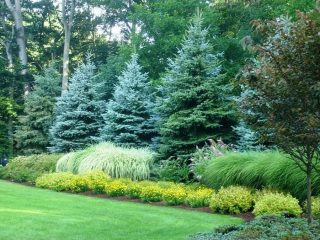Content
Conifer schutte is a common disease that affects many plants. You can fight the disease, but first you should study its types and characteristics.
Description of the disease Schutte
Schutte is a whole group of fungal diseases provoked by a variety of pathogens. The disease affects coniferous plants, leading to the death and shedding of needles. The name of the fungus itself comes from the German schutten, or “to sprinkle.”
Plants become infected with Schutte from sick relatives, and the infection also spreads to healthy specimens from fallen needles and is spread by wind and insects. You can recognize the disease by several symptoms:
- white, gray or moldy growth on the needles;
- changing the shade of the needles from green or bluish to yellow, brown and orange;
- the appearance of black spots and cobwebs on the shoots of the plant.
If left untreated, the infection develops quickly and causes abundant needle drop. Entire branches and wide areas of the trunk are completely exposed.
Conifers affected by the disease lose their decorative properties and stop developing.The disease leads to disruption of nutrition and photosynthesis.
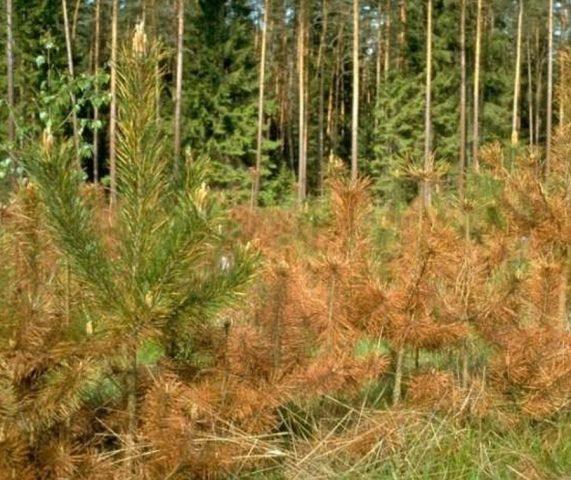
Schutte is very dangerous for conifers in the first three years after planting
Causes
Schutte needles appear on plants in unfavorable conditions. Most often, the disease is provoked by high humidity, which can develop:
- during prolonged rains in cool weather;
- with excessive watering of coniferous trees;
- with excessively tight fit and insufficient ventilation;
- with close proximity to groundwater;
- when the crown of coniferous plants thickens.
Both young and mature trees can suffer from infection. But the latter have a much higher chance of recovering from the disease with proper treatment. The disease poses the greatest danger to young, sensitive seedlings and to plants already weakened by other fungi.
Types of Schutte and their treatment
It is customary to distinguish several types of infection. The diseases have similar symptoms, but they are caused by different fungi.
Ordinary shutte
The causative agent of common scute is the fungus Lophodermium seditiosum. The disease most often affects pine, in the first stages it leads to redness of the needles and the appearance of black stripes. The needles can remain on the branches for a long time - until the beginning of the next season. But already at the end of the first summer, fruiting bodies of the fungus appear on the needles - oval apothecia up to 2 mm long.
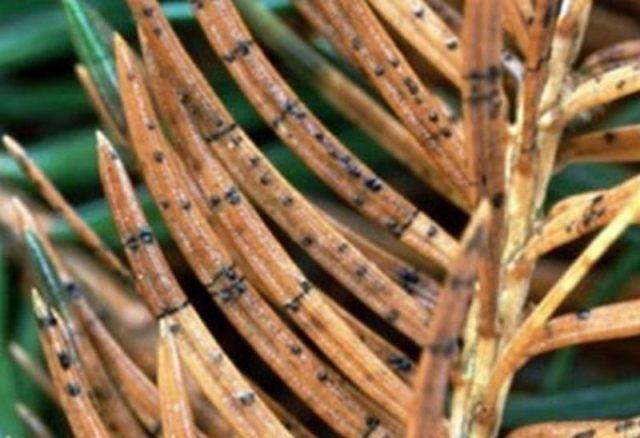
Common scute spreads quickly throughout plantings and requires immediate treatment
Snow conifer shutte (Facidiosis)
The causative agent of snow shutter is the fungus Phacidium infestans. It manifests itself, first of all, as a gray coating that appears on the needles immediately after the snow melts.After some time, the needles become red, and then turn gray again and become covered with black dots. By the end of summer, the needles acquire an ashy hue. The structure of the needles becomes very fragile and crumbles easily, but at the same time they do not fall off the shoots for a long time.
The disease often occurs on trees growing in northern regions with a snow depth of about 50 cm. The fungus develops during the winter even at sub-zero temperatures. Its activation is especially facilitated by a long, cold spring with frequent rains.
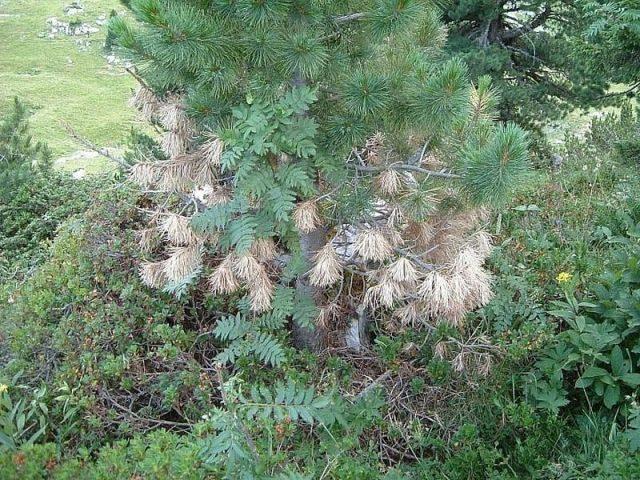
Snow shutter usually affects pine, less often spruce species.
Schutte brown, or brown snow mold
The disease develops under the influence of the fungus Herpotrichia nigra and attacks not only spruce and pine trees, but also cedars, firs and junipers. Trees usually become infected in the fall. In winter, the infection develops under the snow, and with the onset of spring, a brown-black coating forms on the needles.
In September, dark dots become noticeable on the needles - round or pitcher-shaped fruiting bodies of the pathogen. In most cases, the needles remain on the shoots for a long time.
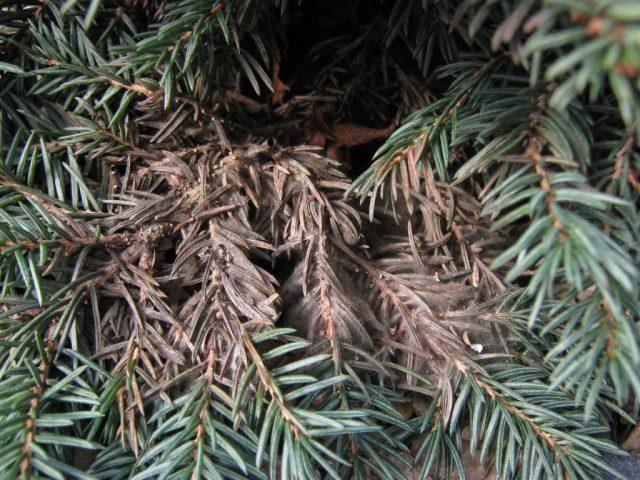
The first symptoms of brown snow chute usually appear in March or April.
Gray shutte
The causative agent of the disease is the fungus Hypodermella sulcigena. Symptoms of the disease in coniferous trees appear in early June - the needles turn yellow and then turn gray at the tips. In this case, the affected and healthy areas are separated by a brown-violet stripe. Over time, small black dots form on the needles that have changed color.

Gray Schutte mainly affects pine trees less than ten years old.
Schutte larch (Meriosis)
The disease can be caused by the fungi Meria laricis or Hypodermella laricis. It manifests itself externally in May; red-brown spots appear on larch needles.Gradually they increase in size, merge with each other and darken, forming a dense coating. White conidia dots appear on the inside of the needles.
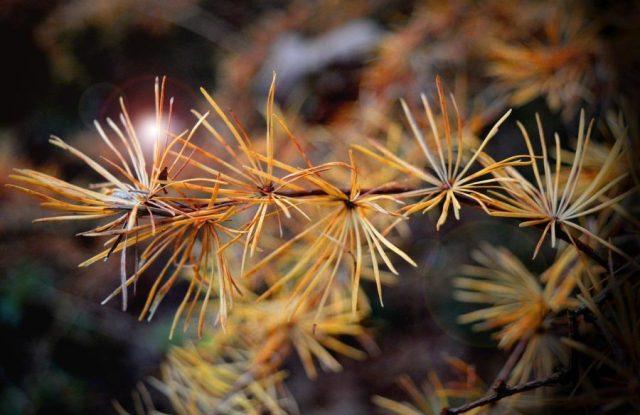
Larch needles with meriosis easily fall off even from a weak wind
Schutte ate
The disease is caused by the pathogen Lophodermium macrosporum. At the end of April or May, the spruce needles turn yellow and brown, and then gradually begin to fall off. The disease develops slowly, and the tree noticeably crumbles only after a year or later. By autumn, the fruiting bodies of the causative agent of the disease become visible on the needles - elongated black growths up to 3.5 mm.
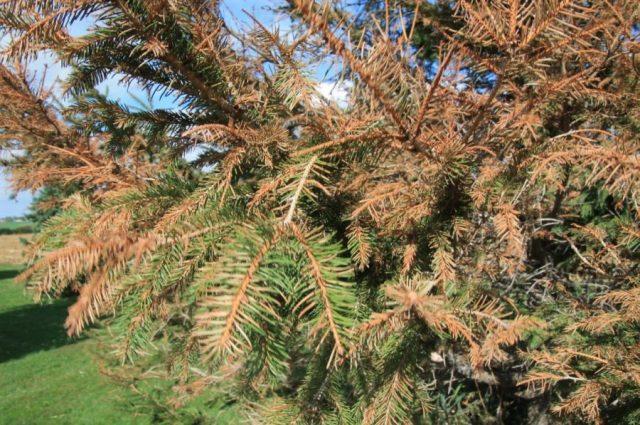
The spruce pathogen tolerates wintering well in harsh conditions and is therefore especially dangerous for conifers.
Juniper Schutte
The disease is provoked by the fungus Lophodermium jiniperinum, under its influence the needles become reddish-brown or yellow. The bottom of the needles is covered with flat or oval black dots, often merging with each other at the tips.
Juniper schutte attacks plants in a wide variety of conditions. But most often coniferous shrubs and trees located on waterlogged soil suffer from the disease.
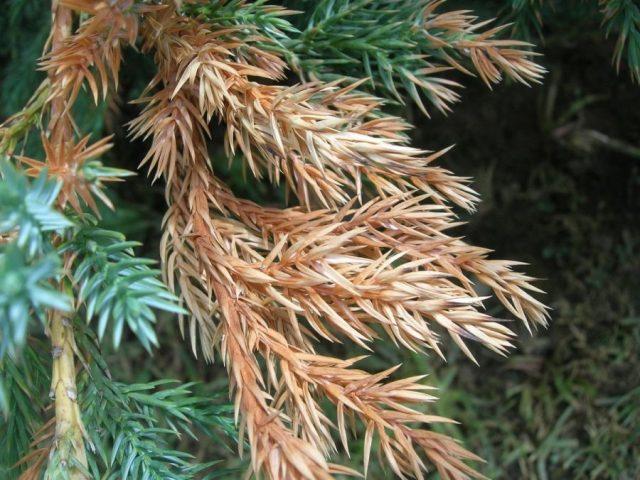
When junipers are densely planted as part of a hedge, the schutte becomes especially dangerous for conifers
Schütte Weymouth pine
Weymouth pine suffers from a fungus from the genus Leptostroma. Schutte is manifested by a change in the color of the needles - the needles become brown, dry out, and become covered with small black dots. The infection usually affects old shoots, but can also affect annual branches.
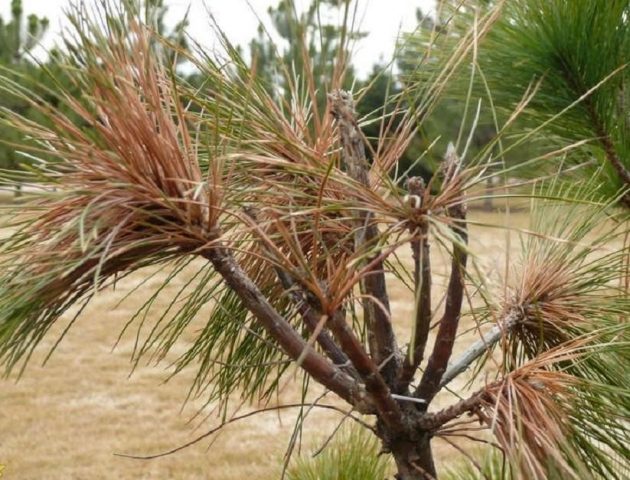
Weymouth pine is considered shade-tolerant, but to prevent shutte it should be planted in light and dry areas
Ways to combat shutte
There are many ways to combat snow shute and other varieties of the disease. At the first symptoms of the disease, it is especially recommended to use several remedies.
Bordeaux liquid
One of the most popular antifungal drugs benefits the early stages of conifer development. Prepare the product as follows:
- Dilute about 300 g of copper sulfate in 5 liters of lukewarm water.
- In a separate container, 300 g of slaked lime is dissolved in a similar amount of liquid.
- Pour copper sulfate into the lye in a thin stream.
- Mix thoroughly.
The resulting preparation is used for spraying conifers along the crown. A 3% solution is used in early spring. If the treatment has to be repeated in the summer, then make a product with a concentration of 1%.
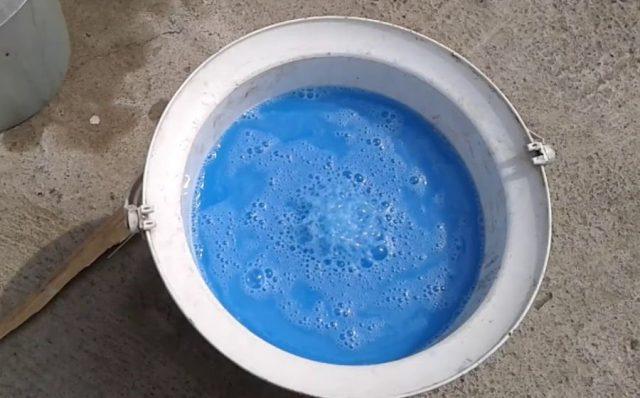
Coniferous trees need to be sprayed with Bordeaux mixture from chute 3-4 times during the season.
Topsin-M
The antifungal drug is used not only for vegetable crops, but also for conifers. The standard medicinal solution is prepared as follows:
- Pour 10-15 g of the drug into 2 liters of warm water.
- Stir until a homogeneous suspension is obtained.
- Add 8 liters of clean liquid.
- Stir thoroughly again.
Spraying of conifers is carried out in dry but cloudy weather. Shake the container every 15 minutes to prevent sediment from appearing at the bottom.
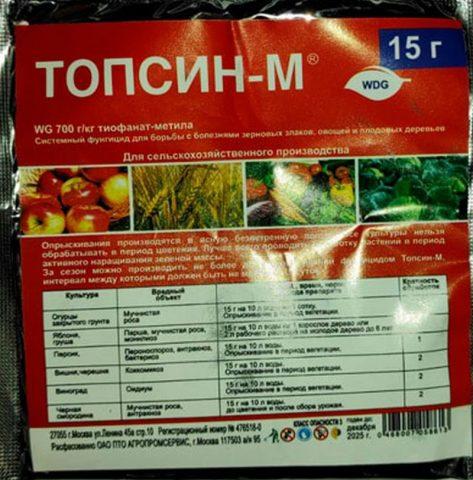
Topsin-M can be used on conifers twice per season with a break of at least two weeks
Nitrophen
Nitrophen is an effective drug designed to destroy pests and fungal microorganisms overwintering in the soil and on pine needles. The working solution is prepared according to the following algorithm:
- About 200 g of the drug is poured with a small amount of water.
- Stir the product properly.
- Bring to a volume of 10 liters and pour into a sprayer.
Coniferous trees are treated in early spring. Re-spraying can be done in late autumn to prevent recurrence of infection.
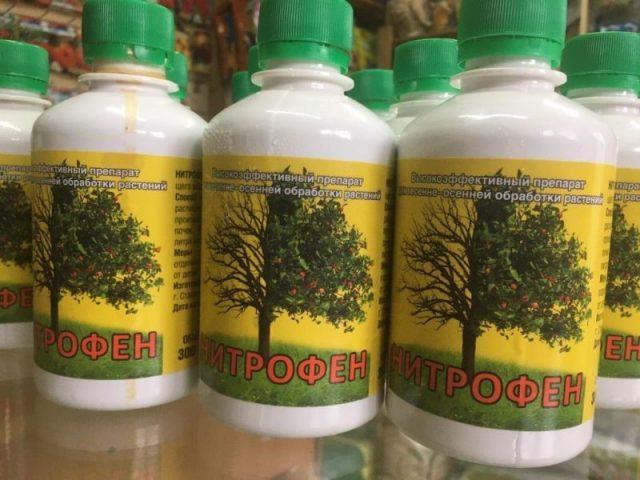
Nitrophen not only copes with fungi, but also neutralizes pests and lichens
Prevention of infection
It is quite difficult to cure coniferous shutte, and in the final stages it is simply impossible. Therefore, priority is given to prevention, which comes down to several points:
- Careful selection of seedlings. For planting, you need to buy only healthy plants with strong roots and green shoots.
- Moderate watering. Some conifers do not respond well to prolonged drought. However, swampy soil also poses a danger for most breeds. Trees and shrubs should be moistened moderately, in accordance with real need.
- The right choice of location. Conifers should be planted in light, well-drained soil. In addition, trees need a lot of light - even hardy spruce trees are not recommended to be placed in dense shade.
- Preventive spraying. In early spring, coniferous crops should be treated with Bordeaux mixture even in the absence of symptoms of Schutte.
Trees that appeared on the site as a result of self-seeding often suffer from infection. It is recommended to remove such plants from the soil in a timely manner and transfer them to a new area with suitable conditions.
If signs of chutte do appear on the site, the affected shoots are cut off and burned before treating the trees with fungicidal agents. If treatment of a coniferous plant does not bring a noticeable effect, it must be eliminated from the area entirely before neighboring specimens become infected.
Conclusion
Schutte of conifers is a common and quite dangerous disease. The main threat is to young trees, leads to a decrease in decorativeness, and over time causes the death of plants.
